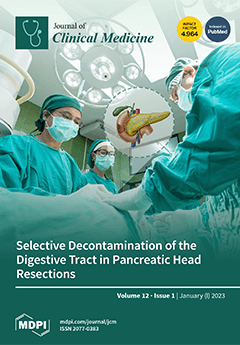Background: Chokeberries (
Aronia spp.) are known to exhibit both direct and indirect antioxidant properties and have been associated with beneficial effects on human health, including cardiovascular risk factors (inflammation, serum lipids, sugars, blood pressure), oxidative stress, and semen quality. This prospective, double-blinded,
[...] Read more.
Background: Chokeberries (
Aronia spp.) are known to exhibit both direct and indirect antioxidant properties and have been associated with beneficial effects on human health, including cardiovascular risk factors (inflammation, serum lipids, sugars, blood pressure), oxidative stress, and semen quality. This prospective, double-blinded, randomized, crossover clinical trial was conducted to elucidate the effects of Aronia supplementation on these health targets in mildly hypercholesterolemic men. Methods: The standardized Aronia supplementation comprised three wild
Aronia spp. (
A. arbutifolia,
A prunifolia and
A. melanocarpa) and the
Aronia hybrid ×
Sorbaronia mitschurinii (standardized to 150 mg anthocyanins daily). Participants (
n = 109) were healthy men with respect to all outcome targets except for the total cholesterol level (5.0–7.0 mM). Participants were randomized to supplementation with either Aronia or placebo for 90 days, followed by a wash-out period and lastly the complementary supplementation. Effects on the health parameters were compared among both the whole group of men and in subgroups according to age, body mass index (BMI), lifestyle, dietary habits, and serum glutathione levels at baseline. The study is registered in ClinicalTrials.gov.: NCT03405753. Results: Glutathione levels were significantly improved after 90 days intake of Aronia supplementation compared to placebo in the subgroup of men with a low level of glutathione at baseline (
p = 0.038) and a high coffee intake (
p = 0.045). A significant decrease in levels of sperm DNA fragmentation and an increase in the percentage of motile sperm were observed in men aged >40 and in men with BMI > 25. Further, these parameters were significantly improved in the dietary subgroup defined by a high level of coffee intake. Total cholesterol and low-density lipoprotein-cholesterol levels decreased significantly in men <40 years after Aronia supplementation. No statistically significant effects were observed regarding blood pressure, markers of blood sugar regulation, hemoglobin A1c, superoxide dismutase, catalase, isoprostane levels, high sensitivity C reactive protein, or other semen parameters. Conclusions: This study demonstrated a significant increase in glutathione levels and improvement of cytoprotective targets following Aronia supplementation in specific subgroups of men >40 years of age and BMI > 25 but did not demonstrate a significant effect in the overall analysis. The observed concurrent increase in glutathione levels and improvement of cytoprotective targets following Aronia supplementation in subgroups of men, suggests that the endogenous phase II antioxidant glutathione is involved in the modulation of the observed cytoprotective effects. This study is a good foundation for further investigation of these cytoprotective effects in groups with oxidative stress in a dose–response study.
Full article






